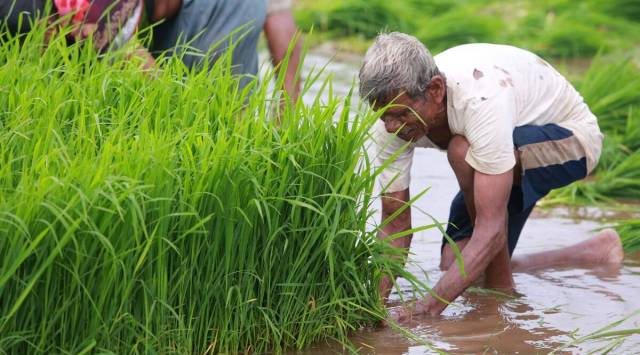Experts suggest alternatives to Punjab’s ‘crippling’ DAP shortage during Rabi season
According to Punjab Agriculture University (PAU), Ludhiana, this is the first method of DAP, which is necessary for root establishment and growth of the crop and is used as a basal dose before sowing.
 Agriculture department officials said that around 55 kilos of DAP are required per acre. (Representational)
Agriculture department officials said that around 55 kilos of DAP are required per acre. (Representational)Punjab requires a total of around 5.50 lakh tonnes of di-ammonium phosphate (DAP) for the Rabi crop season —from October to March. Of this, around 4.80 lakh tonnes of the said fertilizer is required till November alone for timely sowing of wheat crop, which is grown on 35 lakh hectares or in other words 90% of the total area under cultivation for agricultural crops during Rabi season in Punjab. The state, however, this year has got only 45% of the total required DAP to date and only 51% of the quantity of DAP required for wheat sowing. As desperate launch protests and queue up in front of distribution outlets to lay their hands on DAP so that wheat crops can be sowed during the ideal time (from November 1 to November 15th), experts have proposed some phosphorus management interventions for farmers in general and for those who have been incorporating paddy stubble in their respective fields for more than three years in particular.
Soil test based DAP management intervention
According to Punjab Agriculture University (PAU), Ludhiana, this is the first method of DAP, which is necessary for root establishment and growth of the crop and is used as a basal dose before sowing. Diammonium phosphate fertilizer contains 18% of Nitrogen and 46% of phosphorus. This method involves the application of phosphorous to the soil at the time of sowing only, after a test of the soil. “It is very important that phosphorus is applied strictly on the basis of the soil test. If the result of the soil test is in a very high category (more than 20 Kg/acre), then there is no need of applying any phosphatic fertilizers even on wheat in the rice-wheat system. Excessive use of phosphatic fertilizers can cause zinc deficiency in the field crops,” said Dr RK Gupta, principal soil chemist, Department of Soil Sciences, PAU.
According to PAU at present, about 61% of all soil tested comes out to be high (where 9 to 20 kg phosphorus per acre is available). Out of this, around 31% of soil has a very high (more than 20 kg phosphorus per acre) content of phosphorus in Punjab.
Compared to this in 1985, only 21% and 5% of all soil of the state was found to be in the high and very high category. In 2005, 32% of all of Punjab’s soil was found to have high phosphorous content, with 12% of soil having a very high content of phosphorous. In 2020, this percentage shot up further, with 31% of the soil of the state having a very high content of phosphorus and 30% soil having a high content of phosphorus. Around 19% and 20% of all land were deemed to have medium (5-9 kg per acre) and low (less than 5 Kg per acre) phosphorus content, respectively then.
Other inorganic DAP management intervention
Besides the application of phosphorus through DAP, phosphorus can also be applied through Single Super Phosphate (SSP) or NPK — nitrogen, phosphorus, and potassium — (12:32:16) of nitro phosphate (20:20J:13, 20:20:0 and 224:24:0)
Agriculture department officials said that around 55 kilos of DAP are required per acre. So, NPK’s one and half bag (each bag contains 50 kilos of fertilizer) and SSP’s three bags, and ammonium phosphate’s 2.5 bags can be used as a substitute per acre.
Organic DAP management interventions:
If farmyard manure is applied at 20 tonnes per acre to the potato crop along with the recommended fertilizers, then there is no need to apply phosphorus in the succeeding wheat crop, said PAU experts.
“Apply only 75% to 50% of the recommended dose of phosphorus in fields where rice straw has been managed for the last three years,” said Dr OP Chaudhary, head of the department of soil, PAU. He added that if farmers are applying fertilizers, poultry manure /gobar gas slurry (2.4 tonnes per acre), rice husk ash/bagasse ash (4 tonnes per acre), pressmud (6 tonnes per acre) then the usage of DAP can be reduced by 50% of the recommended phosphorus.
Current availability of the DAP, SSP, NPK, and other alternatives in the state
In Punjab as of November 8, at least 2,46,558 tonnes of DAP, 74,039 tonnes of NKP, and 84,827 tonnes of SSP was available, informed Punjab Agriculture Minister, Randeep Nabha, who has been pursuing the issue of DAP shortage with the Centre on a regular basis. Even the combined availability of the three phosphorus fertilizers is not sufficient for wheat sowing and the agriculture minister has been pressing for getting more DAP stocks from the Centre.
Hurdles in adopting organic interventions
For decades, farmers have mostly been dependent on DAP and other inorganic fertilizers and they hardly have used farm yard manure (animal dung), poultry manure, pressmud (available at sugar mills), gobar gas slurry rice husk ash (available at the rice shellers) as they perceive these to be cumbersome methods which are required in huge quantities per acre, as compared to just a few kilos of DAP, NPK, SSP.
“Also now several community gobar gas plants are closed and slurry is hardly available in sufficient amounts. Farmers are hardly preparing farm yard manure and availability of rice husk ash, pressmud, slurry will not be available in sufficient amounts as rice shelling and cane crushing is yet to be started in the state ” said a senior officer in the Punjab Agriculture Department.







